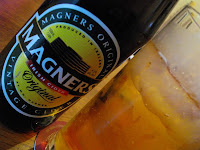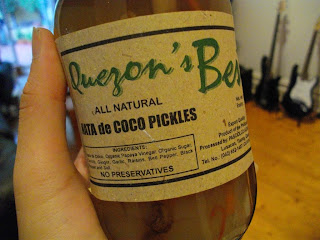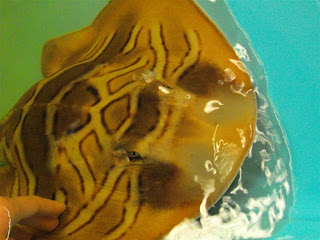Wilson's Promontory, nicknamed the "Prom", is the southernmost point of the Australian mainland. Take the car and drive 3 hours from Melbourne to the South Gippsland Highway, exiting at Fish Creek, and it will be one of the great things you'd never regret doing.

Taking advantage of the long weekend and the much awaited opportunity to do a proper hike, a quick call to 131963 and the bookings were easily done. This is a must for overnight hikes, especially to this route where camping is by permit only. At $14.20 per night (per tent), $28.40 was a very affordable price to pay. The camp sites have a compost toilet (properly enclosed comfort rooms with a toilet bowl dropping your excrement to an enclosure, no water, bring your own toilet paper - inhale before entering the room, do your gig, and remember to put the seat cover down!) and a water source.
Due to a huge number of people flocking to the prom, the original plan of doing Telegraph Saddle - Refuge Cove - Sealer's Cove had to be changed to Telegraph Saddle - Oberon Bay - Refuge Cove. Turned out to be an excellent way to ease in back into the hiking scene in terms of difficulty levels, hours of hiking per day and the awesome scenes that require a bit more time to take in, simply because it was insane not to do so. The hike is a counterclockwise take towards the eastern side of the prom.
Day 1 : Telegraph Saddle Carpark to Oberon BaySummary
12 noon : Depart from Telegraph Saddle Carpark (6.1 km)1:49 pm : Arrive at Oberon Bay (3.4 km)
Total : 9.5kmBy 8am the drive to the Prom had commenced. A portable breakfast of bananas sandwiched in homemade wholewheat pancakes with buttermilk and orange zest gave a good start for the day. By around 11am the booking reference number had been provided to the receptionist by the gate of the Prom and the intrepid trekkers were advised that the road up to the Telegraph Saddle Carpark was closed and a shuttle was provided. This is a normal undertaking during peak season.
Around 30km from the entrance is the Overnight Hikers Carpark where the car was parked (!!!) and the shuttles depart on designated times for the drive up to the Telegraph Saddle Carpark. A good number of hikers were geared up for the challenge, and with the weather forecasted to be hitting 33C, it would be a sweaty day. The hike commenced at 12 noon.
Fortunately, it was not as hot as anticipated, and the good cool breeze from the sea was invigorating. The trail to Oberon Bay was quite easy, made a bit more challenging from the Telegraph Junction because the rocky, pebbly pavement became fine sand. With a backpack to weigh you down further then the footprints in the sand go deeper.
along the way
Nice and early at the camp, a late (packed) lunch of adobo and rice (only because it was decided there would be no stopping along the trail!), an afternoon snooze, dinner of chili, lentils and couscous, and a nightcap of gin and tonic with a squeeze of lemon... No complaints there!
The campsite was quite limited and the water source was like a creek (if that was the proper term). Having known beforehand that water in the campsites require treatment, a pack of Aquatabs Water purification tablets was purchased from the local chemist and brought to the trip. One small tablet can purify 1 liter of water, but if gathered from a creek, a filter may also help remove unwanted grass and silt. In this case, a spare quick-dry t-shirt made of highly breathable material served the purpose!
Easing in for the long trek for the next day was made easy by the tune of the crashing waves. Life has become simpler once again.

cheers!
Featured Drink :
GSM Bluethe nalgene flask cap has an included shot glass

Sunset at Oberon Bay
8:45 Break camp and head to Little Waterloo Bay (8.2 km)10 am Arrive at Little Waterloo Bay
11:15 Depart Little Waterloo Bay, head to Refuge Cove (7.1km)1pm Arrive at Refuge Cove
Total : 15.3kmbreakfast - omelet with chili and coriander, with wholewheat pita bread and coffee
Backtracking to the junction and then branching off to Little Waterloo Bay was not too hard either. Most part of the trail is still sandy and with an early start ahead of the rest of gang sleeping still in their tents, the trail is mostly quiet, only with the birds and rustling of the leaves (perhaps a shy wallaby).
sandy green, or greeny sand?
Boulders that look like a part of Easter Island stand mighty and proud atop a hill, while the trees burned to reduce fuel provide a slightly eerie foreground to the scene. Several steep areas make the heart skip a beat (or thump a little).. or perhaps that was because of a snake crossing the trail? The reptile did slither away quietly though... perhaps the human stink of sweat was a bit too overpowering for the amicable scaly fellow.
Is it Easter Island? And see the snake slither away?
And Little Waterloo Bay.... It was just simply a magical place. The sea was so blue (or turqoise, as they say) that you sometimes can't tell where the sea meets the sky.

beauty beyond words

the awesome white beach
The water was freezing cold but it would just be a shame not to indulge in this paradise!
After an hour in Little Waterloo Bay it was time to resume the walk towards Refuge Cove, the destination for the day.

Campsite is somewhere behind the trees by the shore (a bit to the left side)
The trail to Refuge Cove had a good mix of uphills and downhills, it was very much enjoyable. It was very sunny but most of the trail was covered and the cool breeze was still a constant companion. The campsite is bigger than Oberon Bay, and the water source was flowing water from a hose connected to the creek. The tablets did their magic for drinking purposes, while the rest was boiled away for the pasta dinner that evening.


3-minute rollini with sundried tomatoes, black olives, green peppercorns and mackerel,
finished with freshly grated parmesan cheese!
while the happy tent breathed again, out of the closet and into the wild
The drink of the evening was a flask of Jameson whiskey, unfortunately not enough to knock the living lights out of these trekkers. In the middle of the evening, the girls in the tent-next-door screamed "Help me, help me", while a possum attacked the food that they have left outside their tents. Next time, have more whiskey, and perhaps it is the key to sleep in peace.
Day 3 : Refuge Cove - Sealer's Cove - Telegraph Saddle CarparkSummary
7:45am Depart Refuge Cove and head to Sealer's Cove
9:15am Arrive at Sealer's Cove (6.4km)11am Arrive at Windy Saddle
11:30 Arrive at Telegraph Saddle Carpark, end of hike
the long stretch of beach at Sealer's Cove
The park notes described this leg as "A steady climb to Windy Saddle and then downhill through a beautiful ferny glade and forest to a boardwalk over Sealers Swamp"... but this is from Telegraph Saddle to Sealer's Cove. Hence, because the route was inverted, the trek was uphill after quite a while in the lovely boardwalk in the midst of the forest. But the ascent posed no threat to the "greyhounds" (a remark from an overtaken lady with a nice smile). A five minute break at the Windy Saddle was an attempt to finish off the homemade trailmix made from organic sultanas, raisins and pine nuts, before almost sprinting downhill to the Telegraph Saddle. At this point, the aches and muscle pains were beginning to be a bit more noticeable.
In the car park, some hikers have regrouped to compare notes and discuss separate itineraries. A quick stretch may take the niggles away temporarily, but the experience itself is unforgettable. A pat on the back for a job well done, having enjoyed the hike and achieving hiking times well below the published estimated average compeletion time....an awesome hike to one of the most beautiful places in Victoria, worth a return visit for the southern circuit!!!
The drive back to Melbourne was punctuated with lunch at the Fishy Pub in Fish Creek (a small town called the 'gateway to the Prom'), on the menu was an irresistible kangaroo steak and rabbit snag (it was supposed to be an Emu snag, which would have made it more exotic, but unfortunately it was not available during that day).

ending the hike with a bang-er
For a nice day hike there are options for short walks along the many beaches within the prom, just check out
the website and take your pick on the very enticing list of things to do... especially now that the concept of going to "the Prom" requires no fancy dresses, high heels nor make-up!















.JPG)
.JPG)
.JPG)









.JPG)
.JPG)










